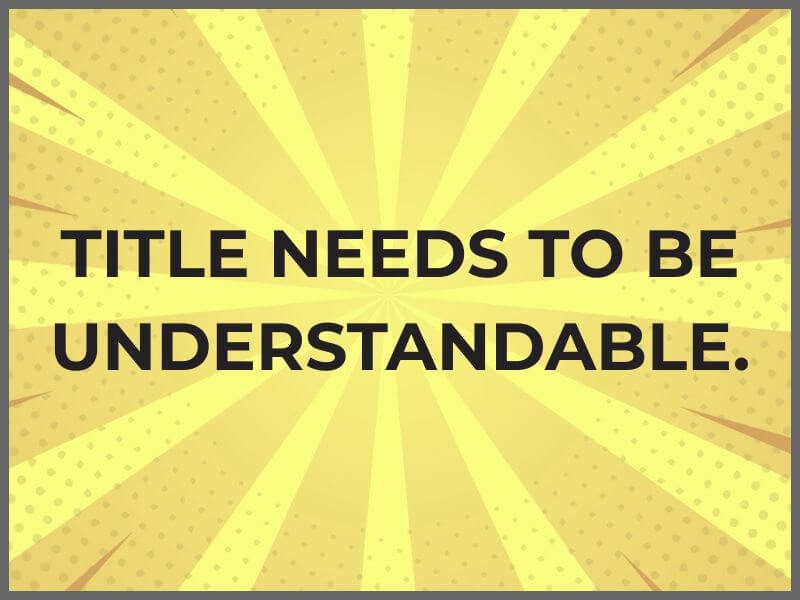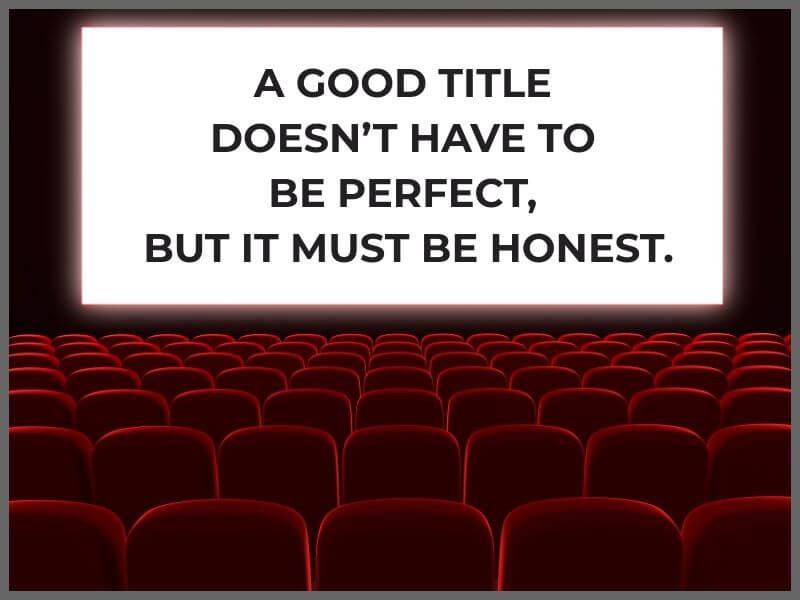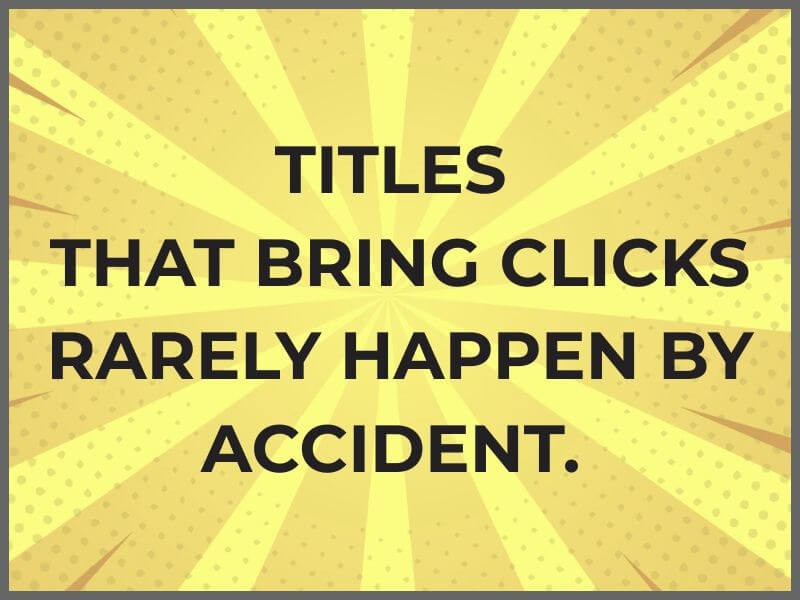
The title is the first thing everyone notices. If the title doesn’t spark interest, the text won’t be read. That’s why the title must be clear, interesting, and precise enough. Is your title like that?
When people search for something, they actually just skim the search results and decide within seconds whether something is worth their click. What they see first is the title.
That’s why you need to know how to write a good title, one that ranks and attracts clicks.
A title, first of all, should show the reader exactly what they will get if they open it. The title doesn’t sell a product, it sells attention. And attention is valuable today.
That’s why it’s important to write titles meant for people, but also for search engines. Google looks for a connection between the title and the content, while the reader looks for something that instantly “clicks” and solves their problem, question, or doubt.
The worst thing you can do is try to sound smart but say nothing.
Good titles:
Weak titles:
A good title should be clear, useful, and state what the reader is already searching for, just better and more specifically than the competition.

The best titles do not come from inspiration, but from understanding what people are really searching for.
If your title answers the query someone has just typed into the search engine, the chances are higher that the person will open it. Not because you guessed the topic, but because you called it by its proper name.
A title does not need to be creative, witty, or different to be good. It needs to be useful. That means giving a clear answer to a real question, without ambiguity.
Google ranks titles better when they match the phrasing of actual queries, especially when written in natural language.
If you are not sure what people are searching for, it is enough to type the beginning of a sentence into the search engine and look at the autocomplete suggestions.
Tools like Google Search Console or websites such as AlsoAsked will help you discover which variations of questions make sense for your topic.
Examples of good titles that solve a question:
Titles based on the audience’s real interest always have a better chance of being opened and also read to the end.

A title that is clever but unclear has missed its purpose.
Wit, wordplay, and ambiguous phrases may sound good in ads or campaigns with visual support, but they do not work well in search.
Google does not read between the lines, and readers also need more time to understand what you actually meant. If they even read it at all.
A title does not have to be boring or generic, it just needs to be immediately understandable.
Even the best text goes unnoticed if the title does not say what it contains. Especially if you are addressing a business audience, they are not looking for wordplay, but for solutions.
If you have to choose between witty and clear, always choose clear.
People who need you will not waste time on texts if they have to interpret the title like a riddle.
Examples of clear titles:
Such titles do not make promises, but do their job – to help someone find you and decide to click.
Titles that include numbers and questions hold attention because people immediately understand what to expect in the text.
Numbers suggest structure, easier readability, and a reading time frame, like: “this is something I can get through quickly.”
A title in the form of a question sparks curiosity and offers a potential answer to something the reader already has in mind. If the reader already has that question in their head, they are likely to click on your text.
The combination of a number and a specific promise is a recipe for good visibility, especially if the topic is business related.
There is no need to invent or struggle if you have certain information that you can present as a list, steps, or tips.
Effective examples:
These titles still work because this is how people still search for answers or browse.

The most common reason a title doesn’t deliver results is not poor style, but a mismatch with what follows.
People click on a title because the topic interests them, but they stay only if they get what was promised.
If the title suggests a guide but the text offers a few shallow sentences, you lose trust.
This doesn’t only hurt one blog post, but your entire content.
Google tracks how long someone stays on a page, how quickly they leave, and whether they click on anything else.
If people regularly close your page immediately after opening it, it is a clear sign something is off – and that lowers the visibility of your whole website.
A good title doesn’t have to be perfect, but it must be honest.
Don’t overpromise. It is better to clearly say what the text offers and attract a smaller number of the right readers than to aim for a broad audience and retain no one.
Examples of poor alignment:
Title: “The best strategies for a blog title”
Content: a few general sentences without examples
Title: “How to attract clients through a blog”
Content: a story about personal experience without guidelines or concrete steps
Examples of functional titles:
A title that leads the reader must deliver what it promises. That is what readers appreciate, and what algorithms reward.
Sometimes the title simply does not deliver results.
It gets fewer clicks than expected, does not rank high in search, or simply does not attract the right audience.
That happens, but do not delete the title and content - change them.
Start with the basics: is the title clear, too long, too general, or simply lacking what people are searching for?
1. Include the keyword, but naturally
Keywords are the link between your content and what someone types into Google. If you are writing about “how to write a good title,” that exact phrase must be present in the title, but in a natural way.
Besides the title, be sure to repeat it in the introduction and subheadings, where it makes sense.
Natural usage:
2. Title length has a limit
Search engines do not display endlessly long titles. If you overdo it, the last part will be cut off. Likewise, a title that is too short will neither attract clicks nor be read. Aim for 50 to 60 characters and place keywords as close to the beginning as possible. This helps both Google and the reader.
Comparison:
Poor: “Practical methods for writing interesting and useful blog titles”
Good: “How to write a title that attracts readers”
3. Adapt the title to the publishing channel
The same title for one topic will not have the same effect everywhere.
On a website, it should be informative, but also optimized for SEO. On Instagram, you can be a bit more provocative or emotional. In a newsletter, be specific. It is important to know who is reading and where.
Examples of adaptation:
Website: How to write a good title for a business blog
Instagram: Tired of titles without substance? Here’s what helps.
Newsletter: Your next title could bring you a customer
4. Test multiple versions
If you have a newsletter, blog, or social media post, test different versions. Sometimes a small change in the verb, word order, or tone can lead to a much better result.
Testing examples:
Version 1: How to write a good title that ranks better
Version 2: Titles that rank: how to write them well
5. Write the title last, but don’t forget it
While writing the text, a working title can serve as a guideline. But the best titles often come at the end, once it is clear what you have emphasized in the text, what the most useful information is, and what might intrigue the reader.
Return to the title before publishing and ask yourself a few questions:
If you can answer “yes” to at least two out of three questions, you are on the right track.

How to write a good title is a skill that is built through writing and analyzing what has been written.
Titles that bring clicks rarely happen by accident. Behind them lies an understanding of the audience, research into search terms, and the knowledge of when to simplify and when to clarify.
It is important to track the number of openings, time spent on the page, and reader behavior after they click.
This tells you whether the title is doing what it should - bringing the right person to the right content.
If not, you can always try again. In digital content, nothing is set in stone - everything can be changed, improved, or tested with another version.
Do not wait for a moment of inspiration or chase the perfect title.
Start with what you have, write about what you know best, and track what works and what doesn’t.
If you want content that gets more attention and truly delivers results, Zona plus can help you at every step - from keyword research and blog writing to crafting titles and tracking real impact.
Contact us if you need content that works for you.